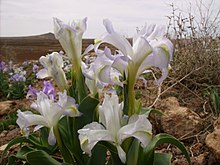| Iris aucheri | |
|---|---|

| |

| |
| Scientific classification | |
| Kingdom: | Plantae |
| Clade: | Tracheophytes |
| Clade: | Angiosperms |
| Clade: | Monocots |
| Order: | Asparagales |
| Family: | Iridaceae |
| Genus: | Iris |
| Subgenus: | Iris subg. Scorpiris |
| Section: | Iris sect. Scorpiris |
| Species: | I. aucheri |
| Binomial name | |
| Iris aucheri (Baker) Sealy | |
| Synonyms | |
|
Iris aucheri var. fumosa Bolt. | |
Iris aucheri, the Aucher-Éloy iris, is a species of flowering plant in the family Iridaceae. It is a bulbous perennial in the Juno group of irises (multiple flowers per plant).
Description
Iris aucheri grows to 25 cm (10 in) tall, with crowded lanceolate (lance-shaped) leaves, producing several flowers in late winter or early spring.
The flowers may be white, pale blue or dark blue, with a yellow splash on the falls. It has a violet-like scent.
Genetics
As most irises are diploid, having two sets of chromosomes, this can be used to identify hybrids and classification of groupings. It has a chromosomal count of 2n = 24. A study in 2014, was carried out on various species of iris DNA, it found that I. iberica subsp. elegantissima had a purity value of 2.80, compared to 1.26 of Iris aucheri.
Taxonomy
The Latin specific epithet aucheri commemorates the 19th century French botanist Pierre Martin Rémi Aucher-Éloy.
It was first described as Xiphion aucheri by Baker and then published as Iris aucheri by Sealy in Kew Bull. page 562 in 1950.
There is a known variant Iris aucheri var. fumosa which was published in 2017.
Distribution and habitat
It is native to temperate Western Asia, in Turkey, Iraq, Iran, Syria and Jordan.
Cultivation
Iris aucheri is cultivated as an ornamental plant in gardens for its showy flowers. It requires neutral or slightly alkaline soil in a sheltered, frost-free spot, or it can be grown in an unheated greenhouse or conservatory, in the UK.
It is hardy down to USDA Zone 6. In the UK, it has been given a hardiness rating by the RHS of H4: −15 °C (5 °F) (hardy in most locations).
This plant species has gained the Royal Horticultural Society's Award of Garden Merit.
References
- "Iris aucheri". International Plant Names Index (IPNI). Retrieved 23 June 2013.
- Austin, Claire (2005). Irises; A Garden Encyclopedia. Timber Press. p. 18. ISBN 0881927309.
- Kamari, G.; Felber, F.; Garbari, F., eds. (1999). "Mediterranean chromosome number reports - 9" (PDF). Flora Mediterranea. 9. Retrieved 16 October 2015.
- Harrison, Lorraine (2012). RHS Latin for gardeners. United Kingdom: Mitchell Beazley. p. 224. ISBN 9781845337315.
- ^ "Taxon: Iris aucheri (Baker) Sealy". npgsweb.ars-grin.gov. Retrieved 2 June 2020.
- "Iris aucheri | International Plant Names Index". www.ipni.org. Retrieved 2 June 2020.
- "Iris aucheri var. fumosa | International Plant Names Index". www.ipni.org. Retrieved 2 June 2020.
- ^ "IRIS FLEUR-DE-LYS Iridaceae (Iris family)". www.hillkeep.ca. 12 May 2008. Retrieved 23 August 2014.
- RHS A-Z encyclopedia of garden plants. United Kingdom: Dorling Kindersley. 2008. p. 1136. ISBN 978-1405332965.
- "Juno irises A-I". Pacific Bulb Society. Retrieved 23 June 2013.
- ^ "RHS Plant Selector - Iris aucheri". Retrieved 19 February 2020.
- "AGM Plants - Ornamental" (PDF). Royal Horticultural Society. July 2017. p. 53. Retrieved 13 March 2018.
| Taxon identifiers | |
|---|---|
| Iris aucheri | |